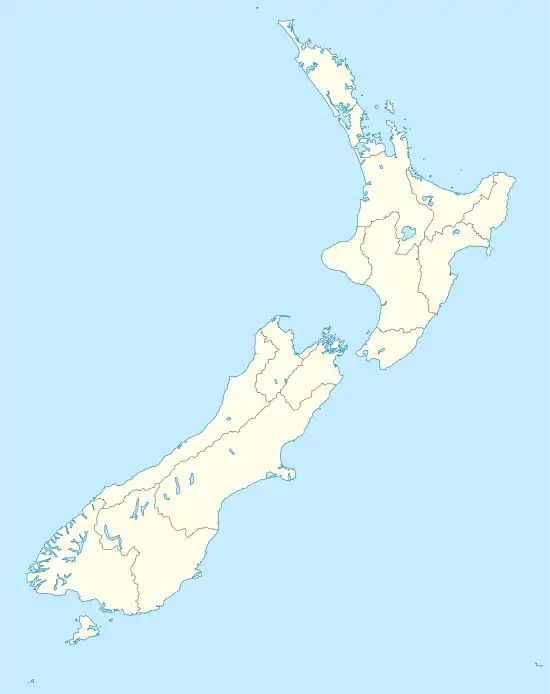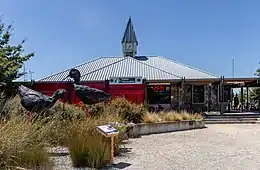Twizel
Twizel (/ˈtwaɪzəl/) is the largest town in the Mackenzie District, in the Canterbury Region of the South Island of New Zealand. The town was founded in 1968 to house construction workers on the Upper Waitaki Hydroelectric Scheme. Twizel has a resident population of 1,650 (June 2020);[1] during the summer, holidaymakers nearly triple the town's population. Twizel is 37km (29 minutes drive) east of Lake Ōhau, 30km (20 minutes drive) north of Omarama and 60km (42 minutes drive) south of Tekapo.
Twizel | |
|---|---|
 | |
 Twizel | |
| Coordinates: 44°15′S 170°06′E | |
| Country | New Zealand |
| Region | Canterbury |
| Territorial authority | Mackenzie District |
| Founded | 1968 |
| Area | |
| • Total | 12.23 km2 (4.72 sq mi) |
| Elevation | 470 m (1,540 ft) |
| Population (June 2020)[1] | |
| • Total | 1,650 |
| • Density | 130/km2 (350/sq mi) |
| Time zone | UTC+12 (NZST) |
| • Summer (DST) | UTC+13 (NZDT) |
| Postcode(s) | 7901 |
| Area code(s) | 03 |

History

The present town was built in 1968 by the Ministry of Works as a greenfields project to house workers constructing the Upper Waitaki hydroelectricity scheme.[2] The name comes from the nearby Twizel River, in turn named for Twizel Bridge in Northumberland by John Turnbull Thomson, Chief Surveyor of Otago in the mid-19th century.[3]
The Waitaki hydro scheme consisted of 50 kilometres (31 mi) of canals, two dams, and four powerhouses (Tekapo B, Ohau A, B and C), and the formation of Lake Ruataniwha, producing 848 MW of electricity.[4][5] At the height of the project in the 1970s, population peaked of around 6,000.[6]
The town was laid out in a 'Scandinavian' fashion, featuring looping roads and pedestrian ways, making it usually far more direct to walk than use a car. Shops, school, and recreational parkland formed a hub in the centre of the town, around which the residential area were built. A previous version of this layout had been tried at Otematata. Accommodation was highly segregated: in addition to single men's quarters in the middle of town, there was a series of different houses available, with the smallest for workers, staff houses for teachers and professionals, and the largest for engineers and other high-status residents.[6]
As the intention was for the town to revert to farmland, there were many temporary features. For example, instead of putting in kerbing, channels, and footpaths at the edge of the road, a single expanse of seal was contoured in a very flat 'W' shape: the seal was highest at the outer edge (footpath) and in the middle (centreline), with a lower area serving as a channel and delineation between the roadway and footpath. Likewise, most of the town's telephone local loop is strung above ground to save the task of burying and then removing the lines. Most houses were prefabricated, and intended to be portable. Some were brought from Otematata, and some were later moved to Clyde for the next hydroelectricity project. However, in 1983, as the hydroelectric project was winding up, residents successfully fought to save the town itself.[6]
Demographics
The Twizel urban area had a usual resident population of 1,455 at the 2018 New Zealand census, an increase of 303 people (26.3%) since the 2013 census, and an increase of 414 people (39.8%) since the 2006 census. There were 765 males and 687 females, giving a sex ratio of 1.11 males per female. Of the total population, 213 people (14.6%) were aged up to 15 years, 243 (16.7%) were 15 to 29, 681 (46.8%) were 30 to 64, and 318 (21.9%) were 65 or older.[7]
Ethnicities were 87.6% European/Pākehā, 9.1% Māori, 0.8% Pacific peoples, 8.0% Asian, and 3.5% other ethnicities (totals add to more than 100% since people could identify with multiple ethnicities).[7]
Tourism and activities

Twizel is now a service and tourist town for visitors. Nearby Lake Ruataniwha supports sailing, water skiing and prominent rowing events such as the Maadi Cup, while the Ohau Skifield and the Round Hill Ski Area attract winter tourists. Twizel is also on the route of the Alps to Ocean Cycle Trail.[8]
The area boasts one of the world's cleanest, driest, and darkest skies, and has long drawn astronomers to Twizel and the surrounding area, with several existing astro-tourism ventures, such as at Lake Tekapo and Omarama, catering to their needs during the development of two additional observatories in Twizel and at Mount Cook Village. Since 2012, Twizel has been a part of the Aoraki Mackenzie International Dark-Sky Reserve, one of sixteen (as of 2020) such reserves in the world recognised by the International Dark-Sky Association.[9]
Climate
| Climate data for Twizel, 473 m | |||||||||||||
|---|---|---|---|---|---|---|---|---|---|---|---|---|---|
| Month | Jan | Feb | Mar | Apr | May | Jun | Jul | Aug | Sep | Oct | Nov | Dec | Year |
| Average high °C (°F) | 22.3 (72.1) |
22.6 (72.7) |
19.8 (67.6) |
16.0 (60.8) |
11.6 (52.9) |
7.4 (45.3) |
7.0 (44.6) |
9.6 (49.3) |
13.1 (55.6) |
15.7 (60.3) |
18.1 (64.6) |
20.2 (68.4) |
15.3 (59.5) |
| Daily mean °C (°F) | 15.7 (60.3) |
15.7 (60.3) |
13.4 (56.1) |
9.9 (49.8) |
6.3 (43.3) |
2.7 (36.9) |
2.3 (36.1) |
4.3 (39.7) |
7.3 (45.1) |
9.8 (49.6) |
11.9 (53.4) |
14.1 (57.4) |
9.5 (49.1) |
| Average low °C (°F) | 9.1 (48.4) |
8.8 (47.8) |
7.0 (44.6) |
3.9 (39.0) |
0.9 (33.6) |
−1.9 (28.6) |
−2.5 (27.5) |
−1.1 (30.0) |
1.5 (34.7) |
3.9 (39.0) |
5.7 (42.3) |
7.9 (46.2) |
3.6 (38.5) |
| Average rainfall mm (inches) | 65.0 (2.56) |
42.0 (1.65) |
61.0 (2.40) |
53.0 (2.09) |
57.0 (2.24) |
51.0 (2.01) |
56.0 (2.20) |
61.0 (2.40) |
64.0 (2.52) |
69.0 (2.72) |
57.0 (2.24) |
61.0 (2.40) |
697.0 (27.44) |
| Source 1: Climate-data.org[10] | |||||||||||||
| Source 2: weatherbase.com[11] | |||||||||||||
Transport
State Highway 8 is the main highway serving the town, which is also served by the nearby Pukaki Airport.[12]
Twizel is served by InterCity coaches with regular service to Christchurch and Queenstown.[13] The Cook Connection bus service also provides connections to Mount Cook village from Twizel.[14]
Education
Twizel Area School is the sole school in Twizel, catering for Year 1 to 13 students (ages 5 to 18). Established in 1986 following the merger of Twizel Primary School and Twizel High School, the co-educational school has a roll of 219 students as of March 2020.[15]
In popular culture
In the movie The Lord of the Rings: The Return of the King, the battle of the Pelennor Fields was filmed near Twizel[16] - as was a scene in The Hobbit trilogy of movies where Bilbo and the Dwarves are chased across the plains by Warg riders.[17]
References
- "Population estimate tables - NZ.Stat". Statistics New Zealand. Retrieved 22 October 2020.
- "Mackenzie Country". Te Ara. Retrieved 16 March 2020.
- "Twizel: Meaning of place name". NZ History. Retrieved 21 July 2017.
- "A HUGE SCHEME AND A LONG BUILD", JUNE 12TH, 2013, Vijay Naidu, EnergyNZ Magazine
- "Discover Waitaki", Meridian pamphlet
- "Town saved from the bulldozers", 30 Nov 2013, David Bruce, Otago Daily Times.
- "Age and sex by ethnic group (grouped total response), for census usually resident population counts, 2006, 2013, and 2018 Censuses (urban rural areas)". nzdotstat.stats.govt.nz. Retrieved 13 September 2020.
- "Cycling from New Zealand's Alps to the ocean", Andrew Bain, Feb 26, 2015, "Australian Geographic"
- "International Dark Sky Reserves". International Dark-Sky Association. Retrieved 8 July 2020.
- "Climate-data.org – Climate Data for Cities Worldwide".
- "Weatherbase". openstreetmap.org. CantyMedia. Retrieved 30 November 2020.
- "Pukaki Airport Development". www.airportpukaki.co.nz. Retrieved 25 January 2019.
- "Twizel - Bus Timetable // Search Bus Fares From Twizel". www.intercity.co.nz. Retrieved 18 May 2019.
- "Timetable - The Cook Connection". www.cookconnect.co.nz. Retrieved 18 May 2019.
- "New Zealand Schools Directory". New Zealand Ministry of Education. Retrieved 26 April 2020.
- "The Lord of the Rings filming locations | 100% Pure New Zealand". www.newzealand.com. Retrieved 20 September 2020.
- Coates, Joe. "8 New Zealand Locations Filmed in The Hobbit Trilogy". Culture Trip. Retrieved 20 September 2020.
Further reading
- Sheridan, Marion (1995). Dam Dwellers – End of an Era. Twizel: Sheridan Press. pp. 392 pages. ISBN 0-473-03402-6.